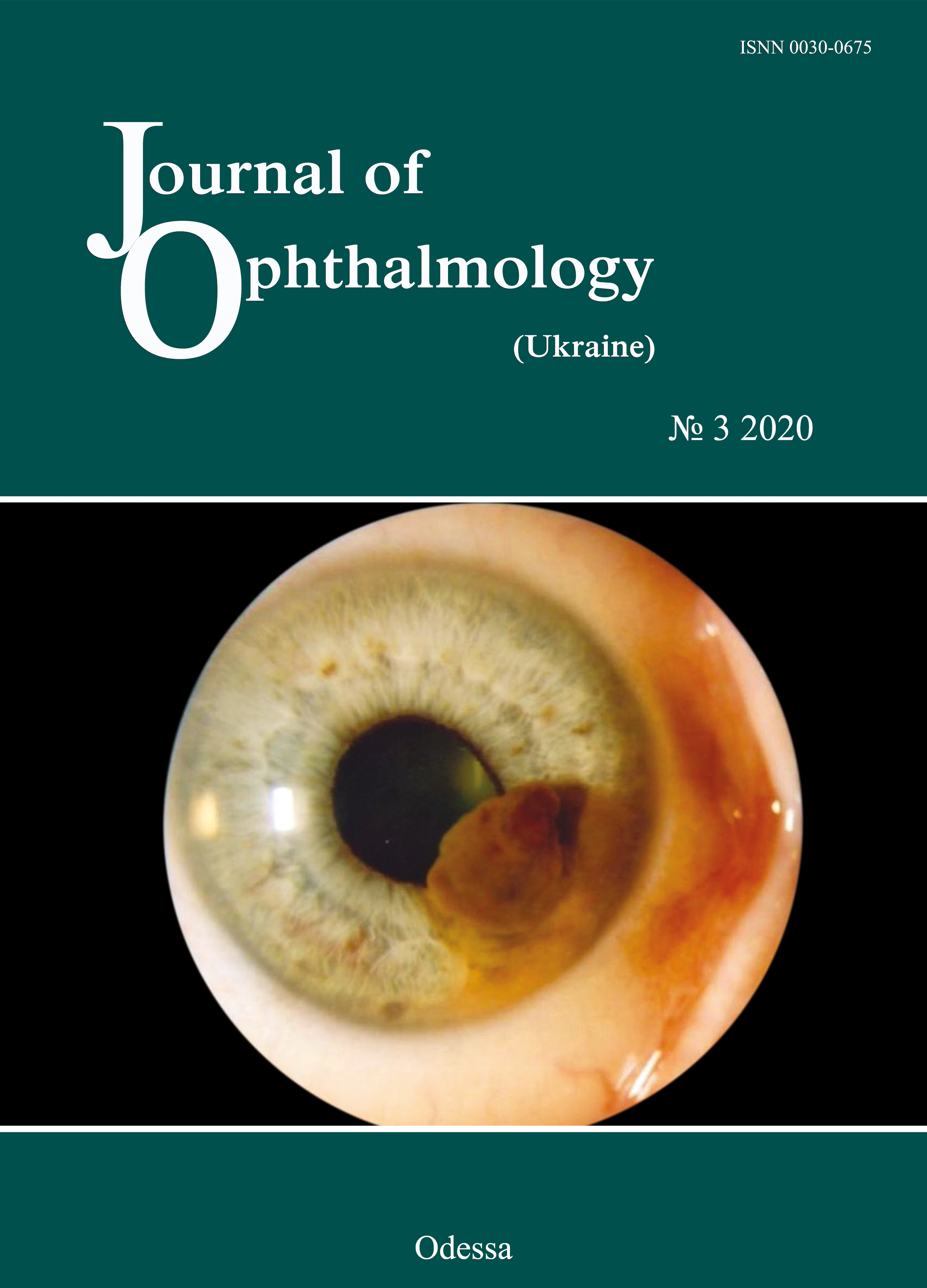Перспективы применения современных антиоксидантов в лечении хронических заболеваний глаз
DOI:
https://doi.org/10.31288/oftalmolzh202034246Ключові слова:
окислительный стресс, ВМД, глаукома, диабетическая ретинопатия, антиоксиданты, астаксантинАнотація
По данным ВОЗ, в мире около 285 миллионов человек страдают от нарушений зрения, из которых 39 миллионов поражены слепотой и 246 миллионов имеют пониженное зрение. Около 90% людей, страдающих от нарушений зрения, живут в странах с низким уровнем дохода. 82% людей, страдающих слепотой, входят в возрастную группу 50 лет и старше, в то время как эта возрастная группа составляет 20% населения мира.
Сегодня уже не вызывает сомнения роль свободных радикалов в развитии таких заболеваний как ВМД, глаукома, катаракта, диабетическая ретинопатия, которые занимают ведущее место среди причин инвалидности по зрению в Украине.
Одним из самых мощных антиоксидантов является астаксантин, превышающий по своей эффективности лютеин и зеаксантин. В результате высокой биодоступности, возможности преодолевать гематоэнцефалический барьер, а также многогранного механизма действия, его применение может быть эффективным в лечении хронической инвалидизирующей патологии, такой как глаукома, диабетическая ретинопатия, возрастная макулярная дегенерация.
Посилання
1.Ackland P, Resnikoff S, Bourne R. World blindness and visual impairment: despite many successes, the problem is growing. World blindness and visual impairment: despite many successes, the problem is growing. Community Eye Health. 2017;30(100):71-3.
2.World Health Organization. Blindness and Vision Impairment. [(accessed on 14 June 2019)];Available online: https://www.who.int/news-room/fact-sheets/detail/blindness-and-visual-im.
3.Vitovska OP. [Health promotion strategy in ophthalmology]. Russkii meditsinckii zhurnal. Klinicheskaia odtalmologiia. Glaukoma. 2013;3:88-92. Russian.
4.Chader GJ, Taylor A. Preface: The Aging Eye: Normal Changes, Age-Related Diseases, and Sight-Saving Approaches. Invest Ophthalmol Vis Sci. 2013 Dec 13;54(14):ORSF1-4.https://doi.org/10.1167/iovs.13-12993
5.Li JQ, Welchowski T, Schmid M. Retinal diseases in Europe: prevalence, incidence and healthcare needs. European Society of Retina Specialists (EURETINA). 2017; 1-28. Available online: http://www.euretina.org/downloads/EURETINA_Retinal_Diseases.pdf
6.Vitovska OP, Vasiuta VA. [Pathways for improving medical care for patients with optic nerve atrophy]. Skhidnoievropeiskyi zhurnal gromadskogo zdorovia. 2015;1(26):58-9. Ukrainian.
7.Vitovska OP, Alifanova TA, Poveshchenko IuL. [Epidemiological aspects of primary disability caused by glaucoma in Ukraine]. Oftalmologiia. 2016;2(4):16-26. Russian.
8.Vitovska OP, Vasiuta VA. [Analysis of the dynamics of prevalence of optic nerve atrophy in Ukraine]. Visnyk naukovykh doslidzhen. 2015;3:72-5. Ukrainian.
9.Polumbryk M, Ivanov S, Polumbryk O. Antioxidants in food systems. Mechanism of action. Ukr J Food Sci. 2013;1:15-40.
10.Carocho M, Ferreira I.C.F.R. A review on antioxidants, prooxidants and related controversy: natural and synthetic compounds, screening and analysis methodologies and future perspectives. Food Chem Toxicol. 2013 Jan;51:15-25.https://doi.org/10.1016/j.fct.2012.09.021
11.Reznikov AG, Polumbryk OM, Balion IaG, Polumbryk MO. [Pro- and anti-oxidative systems and pathological processes in the human body]. Visnyk NAN Ukrainy. 2014;10:17-29. Ukrainian.
12.Britton G. [The Biochemistry of Natural Pigments]. Moscow: Mir; 1986. Russian.
13.Kishimoto Y, Tani M, Uto-Kondo H, Iizuka M et al. Astaxanthin suppresses scavenger receptor expression and matrix metalloproteinase activity in macrophages. Eur J Nutr. 2010; 49: 119-26.https://doi.org/10.1007/s00394-009-0056-4
14.Hussein G, Goto, H, Oda, S, Sankawa, U et al. Antihypertensive potential and mechanism of action of astaxanthin: III. Antioxidant and histopathological effects in spontaneously hypertensive rats. Biol Pharm Bull. 2006; 29:684-8.https://doi.org/10.1248/bpb.29.684
15.Ranga Rao A, Raghunath Reddy RL, Baskaran V, Sarada R, Ravishankar GA. Characterization of microalgal carotenoids by mass spectrometry and their bioavailability and antioxidant properties elucidated in rat model. J Agric Food Chem. 2010 Aug 11;58(15):8553-9.https://doi.org/10.1021/jf101187k
16.Bohn T. Bioavailability of non-provitamin A carotenoids. Curr Nutr Food Sci. 2008;4:240-58.https://doi.org/10.2174/157340108786263685
17.Miki W. Biological functions and activities of animal carotenoids. Pure Appl Chem. 1991;63:141-6.https://doi.org/10.1351/pac199163010141
18.Palozza P, Krinsky NI. Astaxanthin and canthaxanthin are potent antioxidants in a membrane model. Arch Biochem Biophys. 1992 Sep;297(2):291-5.https://doi.org/10.1016/0003-9861(92)90675-M
19.Nishigaki I, Rajendran P, Venugopal R, Ekambaram G et al. Cytoprotective role of astaxanthin against glycated protein/iron chelate-induced toxicity in human umbilical vein endothelial cells. Phytother Res. 2010 Jan;24(1):54-9.https://doi.org/10.1002/ptr.2867
20.Papas AM. Antioxidant Status, Diet, Nutrition, and Health. Washington, DC: CRC Press; 1999.
21.Greene L. Asthma and oxidant stress: Nutritional, environmental, and genetic risk factors. J Am Coll Nutr. 1995 Aug;14(4):317-24.https://doi.org/10.1080/07315724.1995.10718516
22.Higuera-Ciapara I, F?lix-Valenzuela L, Goycoolea FM. Astaxanthin: a review of its chemistry and applications. Crit Rev Food Sci Nutr. 2006; 46(2):185-96. https://doi.org/10.1080/10408690590957188
23.Hussein G, Sankawa U, Goto H, Matsumoto K, Watanabe H. Astaxanthin, a carotenoid with potential in human health and nutrition. J Nat Prod. 2006 Mar;69(3):443-9.https://doi.org/10.1021/np050354+
24.Nagaki Y, Mihara M, Tsukahara H, Ono S. The supplementation effect of astaxanthin on accommodation and asthenopia. J Clin Ther Med. 2006; 22:41-54.
25.Liao JH, Chen CS, Maher TJ, Liu CY et al. Astaxanthin interacts with selenite and attenuates selenite-induced cataractogenesis. Chem Res Toxicol. 2009 Mar 16;22(3):518-25.https://doi.org/10.1021/tx800378z
26.Izumi-Nagai K, Nagai N, Ohgami K, Satofuka S, Ozawa Y, Tsubora K et al. Inhibition of choroidal neovascularization with an anti-inflammatory carotenoid astaxanthin. Invest Ophthalmol Vis Sci. 2008 Apr;49(4):1679-85.https://doi.org/10.1167/iovs.07-1426
27.Wu TH, Liao JH, Hou WC, Huang FY, Maher TJ, Hu CC. Astaxanthin protects against oxidative stress and calcium-induced porcine lens protein degradation. J Agric Food Chem. 2006 Mar 22;54(6):2418-23.https://doi.org/10.1021/jf052651q
28.Nakajima Y, Inokuchi Y, Shimazawa M, Otsubo K, Ishibashi T, Hara H. Astaxanthin, a dietary carotenoid, protects retinal cells against oxidative stress in vitro and in mice in vivo. J Pharm Pharmacol. 2008 Oct;60(10):1365-74.https://doi.org/10.1211/jpp/60.10.0013
29.Cort A, Ozturk N, Akpinar D, Unal M, Yucel G, Ciftcioglu A, et al. Suppressive effect of astaxanthin on retinal injury induced by elevated intraocular pressure. Regul Toxicol Pharmacol. 2010 Oct;58(1):121-30.https://doi.org/10.1016/j.yrtph.2010.05.001
30.Otton R, Marin DP, Bolin AP, Santos RDe C, Polotow TG, Sampaio SC, et al. Astaxanthin ameliorates the redox imbalance in lymphocytes of experimental diabetic rats. Chem Biol Interact. 2010 Aug 5;186(3):306-15.https://doi.org/10.1016/j.cbi.2010.05.011
31.Nishigaki I, Rajendran P, Venugopal R, Ekambaram G, Sakthisekaran D, Nishigaki Y. Cytoprotective role of astaxanthin against glycated protein/iron chelate-induced toxicity in human umbilical vein endothelial cells. Phytother Res. 2010 Jan;24(1):54-9.https://doi.org/10.1002/ptr.2867
32.Hussein G, Nakagawa T, Goto H, Shimada Y, Matsumoto K, Sankawa U, et al. Astaxanthin ameliorates features of metabolic syndrome in SHR/NDmcr-cp. Life Sci. 2007 Jan 16;80(6):522-9.https://doi.org/10.1016/j.lfs.2006.09.041
33.Chan KC, Mong MC, Yin AC. Antioxidative and anti-inflammatory neuroprotective effects of astaxanthin and canthaxanthin in nerve growth factor differentiated PC12 cells. J Food Sci. 2009 Sep;74(7):H225-31.https://doi.org/10.1111/j.1750-3841.2009.01274.x
34.Liu XB, Shibata T, Hisaka S, Osawa T. Astaxanthin inhibits reactive oxygen species-mediated cellular toxicity in dopaminergic SH-SY5Y cells via mitochondria-targeted protective mechanism. Brain Res. 2009 Feb 13;1254:18-27.https://doi.org/10.1016/j.brainres.2008.11.076
##submission.downloads##
Опубліковано
Як цитувати
Номер
Розділ
Ліцензія
Авторське право (c) 2025 О. П. Витовская, Л. Д. Пичкур

Ця робота ліцензується відповідно до Creative Commons Attribution 4.0 International License.
Ця робота ліцензується відповідно до ліцензії Creative Commons Attribution 4.0 International (CC BY). Ця ліцензія дозволяє повторно використовувати, поширювати, переробляти, адаптувати та будувати на основі матеріалу на будь-якому носії або в будь-якому форматі за умови обов'язкового посилання на авторів робіт і первинну публікацію у цьому журналі. Ліцензія дозволяє комерційне використання.
ПОЛОЖЕННЯ ПРО АВТОРСЬКІ ПРАВА
Автори, які подають матеріали до цього журналу, погоджуються з наступними положеннями:
- Автори отримують право на авторство своєї роботи одразу після її публікації та назавжди зберігають це право за собою без жодних обмежень.
- Дата початку дії авторського права на статтю відповідає даті публікації випуску, до якого вона включена.
ПОЛІТИКА ДЕПОНУВАННЯ
- Редакція журналу заохочує розміщення авторами рукопису статті в мережі Інтернет (наприклад, у сховищах установ або на особистих веб-сайтах), оскільки це сприяє виникненню продуктивної наукової дискусії та позитивно позначається на оперативності і динаміці цитування.
- Автори мають право укладати самостійні додаткові угоди щодо неексклюзивного розповсюдження статті у тому вигляді, в якому вона була опублікована цим журналом за умови збереження посилання на первинну публікацію у цьому журналі.
- Дозволяється самоархівування постпринтів (версій рукописів, схвалених до друку в процесі рецензування) під час їх редакційного опрацювання або опублікованих видавцем PDF-версій.
- Самоархівування препринтів (версій рукописів до рецензування) не дозволяється.












